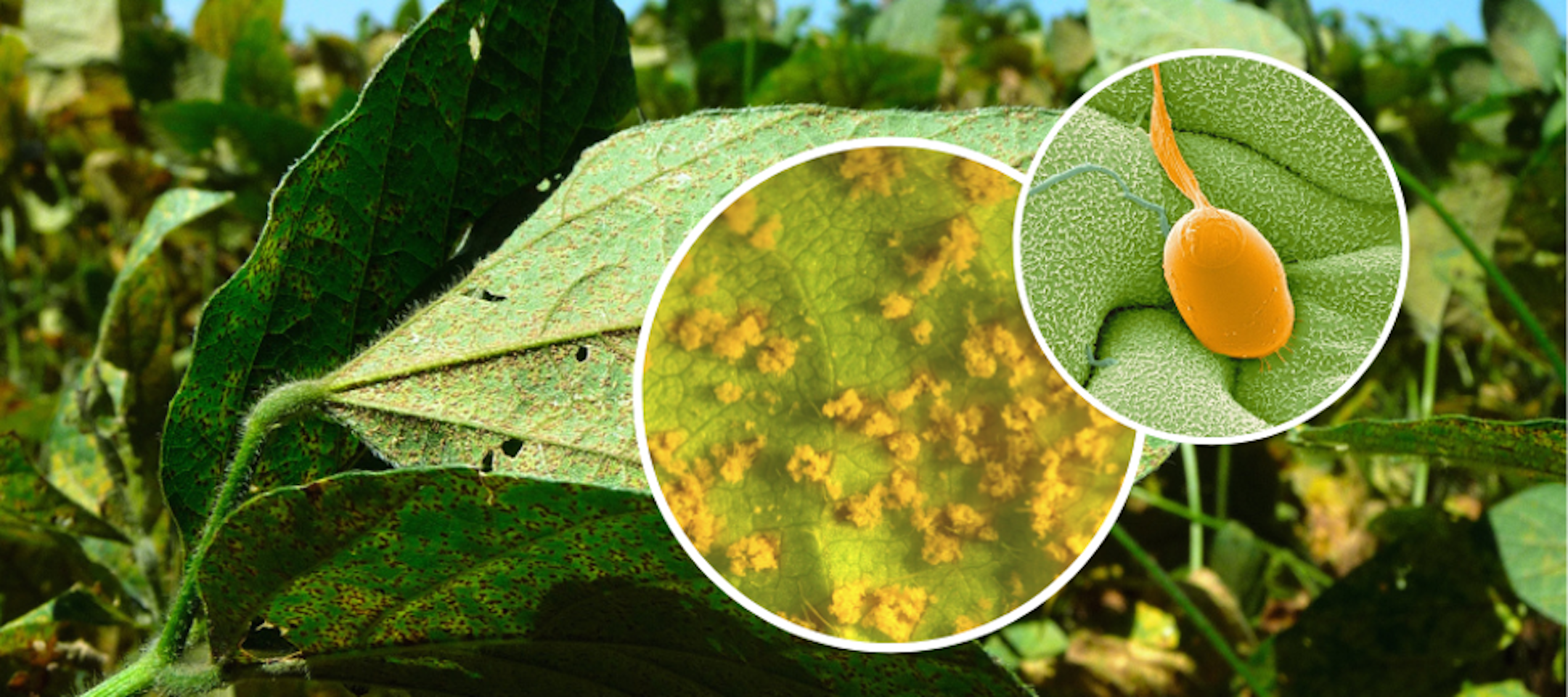
Soybean
Soybean rust (SBR) can destroy up to 90% of a soybean crop within just 3 weeks of initial infection, making it one of the most devastating diseases of soybean. This project has identified novel sources of genetic resistance to develop soybean varieties with durable resistance to this aggressive, fast-moving disease.
At a Glance
Crop(s): Soybean
Global Production: 430 million tons
Disease: Soybean rust (SBR), Phakopsora pachyrhizi
Region(s) Affected: South America; Africa
Loss/Costs: Losses up to 90%, over $2 Billion in fungicide costs in Brazil alone
Project Lead: Kamil Witek
Collaborators: Bayer Crop Science, The Sainsbury Laboratory, International Institute of Tropical Agriculture (IITA), Corteva
SBR-infected soybean fields in Brazil
Photo Source: 2Blades; Inset: Kathrin Thor
The Challenge
Soybean rust (SBR) is caused by the airborne fungus Phakopsora pachyrhizi and can cause yield losses of up to 90% within just three weeks of infection. SBR was first detected in Brazil during the 2001/2002 growing season, a country that produces nearly 40% of the world's soybeans. Due to the Brazilian climate and the large acreage of soybean, this disease quickly reached epidemic proportions. Managing soybean rust now requires more fungicide than any other disease, costing Brazil approximately $2 billion annually. Moreover, the highly adaptable fungus has overcome the efficacy of fungicides used for its control each year.
Soybean is a valuable crop for smallholder and larger farmers alike, because of its climate tolerance, high protein and oil content for food and feed, and ability to enhance soil nitrogen.
The largest expansion of soybean cultivation today is occurring in Africa. Many smallholder farmers view soybean as a cash crop because of its climate tolerance, high protein and oil content, and ability to enhance soil nitrogen. However, fungicides are neither affordable nor sustainable, making soybean rust the leading cause of yield loss in the region.
Phakopsora pachyrhizi sporulating on a soy leaf
The Strategy
Soybean germplasm is derived from a narrow genetic base, and extensive screening for useful resistance has yielded few candidate genes. Moreover, the soybean resistance genes that have been deployed in the field have not proved durable.
Although resistance against SBR is rare in soybean itself, resistance in other legume hosts of P. pachyrhizi is more common. We have identified novel sources of resistance in related legumes such as Pigeonpea, and we are testing their effectiveness in soybeans.
By using our high-capacity resistance gene discovery platforms, such as NLRseek™, together with resistance genes already in hand, we are working to help deliver benefits for commercial soy producers and smallholder farmers, with an initial focus on Kenya.
The Science
Phakopsora pachyrhizi is able to infect leaf tissue from numerous leguminous plants belonging to different genera (more than 153 species) under field and laboratory conditions. Seven major Resistance to Phakopsora pachyrhizi (Rpp genes) have been described, but they have already been overcome by at least one isolate throughout the world. Moreover, existing fungicides are losing efficacy, leaving crops vulnerable to infection.
Our commercial program has isolated effective SBR resistance genes from soybean relatives. Combined with our NLRseek™ platform, we are assembling a set of effective resistances to deploy in high-yielding, regionally-adapted soy in East Africa as well.
In conjunction with the resources of regional partners, we are adding information about the genetic diversity of SBR populations across East Africa from phenotypic performance of a panel of soybean varieties. We aim to identify the pathogen effectors contributing to virulence, as well as the R genes that recognize their activity.
A better understanding of the pathogen race structure will enhance field monitoring, enable an early warning system, and provide an advantage to farmers and breeders to better adapt management strategies.




